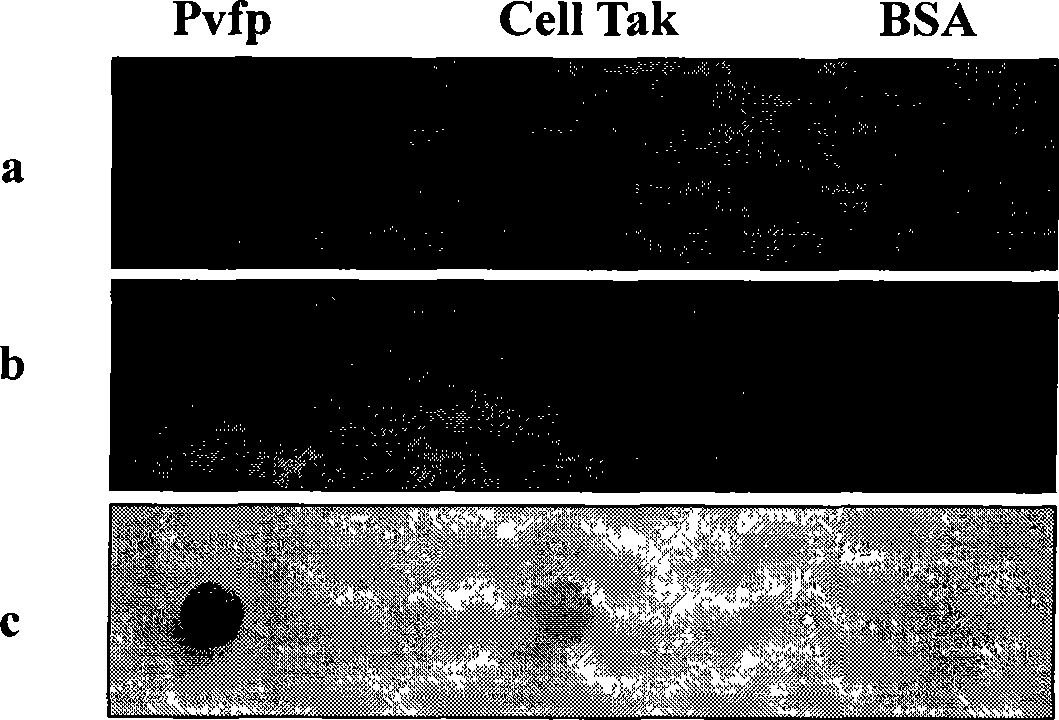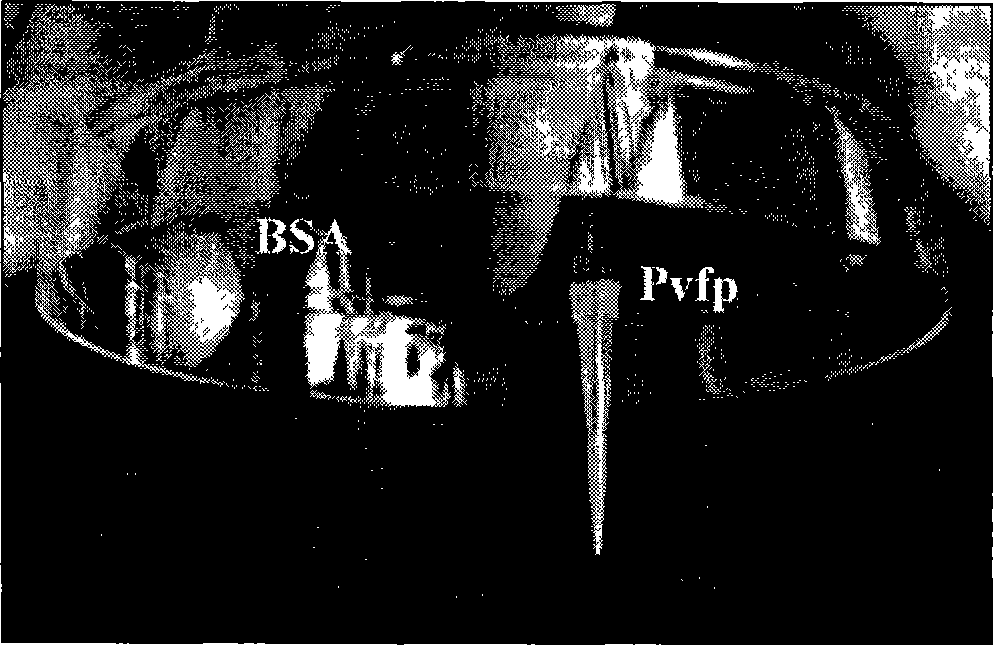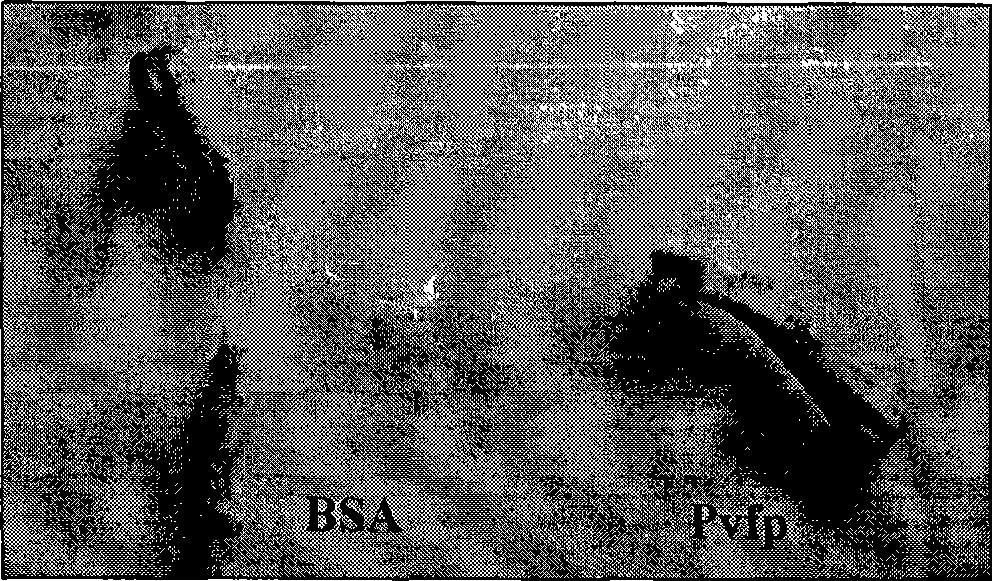Method for preparing biology adhesive using emerald mussel adhesion protein
A mussel adhesion protein and bioadhesive technology, which is applied in surgical adhesives, applications, medical science, etc., can solve the problems of high price, difficulty in meeting needs, and few adhesion proteins, and achieve low cost and easy preparation. Convenience, Inexpensive Effects
- Summary
- Abstract
- Description
- Claims
- Application Information
AI Technical Summary
Problems solved by technology
Method used
Image
Examples
Embodiment 1
[0023] Embodiment 1: the preparation of emerald mussel adhesive protein bioadhesive (Pvfp)
[0024] 1. Obtaining and homogenizing the feet of Emerald Mussels: Take live Emerald Mussels with a shell length of 13-14 cm, cut off their feet, weigh the feet with a fresh weight of 30 g, wash them in ice-precooled PBS, and put them in Contain 0.5% methanol pepstatin A (China Solarbio company) 30μM, leupeptin (Amersco company in the United States) 30μM and PMSF (BBI company in the United States) 1mM ice-cold 180ml 5% acetic acid, use T18 basic ( Germany IKA Company) tissue disperser, homogenate on ice for 2 minutes, pour the homogenate into a centrifuge tube, centrifuge at 20000g, 4°C for 60 minutes;
[0025] 2. Protein acidification: Discard the precipitate after centrifugation, take the supernatant S1, and record the volume V1, place the supernatant S1 on ice for pre-cooling, and slowly add 60% perchloric acid (PCA) to a final concentration of 1% (V 60%PCA =V1 / 59ml), stirred gently...
Embodiment 2
[0028] Example 2: Adhesion of Emerald mussel adhesion protein bioadhesive (Pvfp) on different material surfaces in a humid environment
[0029] Add 10 μl of emerald mussel bioadhesive with a concentration of 1.44 mg / ml dropwise on the cleaned plastic, glass, metal titanium and other materials, and add bovine serum albumin (BSA, bovine serum albumin) with the same concentration at the same time and CELL-TAK TM Make negative and positive controls respectively, place them in a humid environment at 25°C for 12 hours, take them out and dry them, wash them with distilled water for 2 hours, and then stain them with Coomassie Brilliant Blue R250, as figure 1 As shown, the results show that on the surface of glass slide a and titanium material b, the bioadhesive of emerald mussel adhesion protein (Pvfp) and CELL-TAK TM The adhesion ability of CELL-TAK is similar, while on the surface of plastic Petri dish c, Emerald mussel adhesion protein bioadhesive (Pvfp) has a higher than CELL-TAK...
Embodiment 3
[0030] Embodiment 3: Emerald mussel adhesive protein bioadhesive (Pvfp) bonding laboratory plastic consumables
[0031] Add 4 μl of 1.44 μg / μL emerald mussel bioadhesive dropwise on a laboratory consumable plastic Petri dish, place a white plastic pipette tip on the protein spot, and use BSA as a negative control. Place in a humid environment at 25°C for 12 hours. see results figure 2 , the emerald mussel adhesive protein bioadhesive (Pvfp) bonded the plastic Petri dish to the pipette tip together, which BSA failed to perform.
PUM
 Login to View More
Login to View More Abstract
Description
Claims
Application Information
 Login to View More
Login to View More - R&D
- Intellectual Property
- Life Sciences
- Materials
- Tech Scout
- Unparalleled Data Quality
- Higher Quality Content
- 60% Fewer Hallucinations
Browse by: Latest US Patents, China's latest patents, Technical Efficacy Thesaurus, Application Domain, Technology Topic, Popular Technical Reports.
© 2025 PatSnap. All rights reserved.Legal|Privacy policy|Modern Slavery Act Transparency Statement|Sitemap|About US| Contact US: help@patsnap.com



